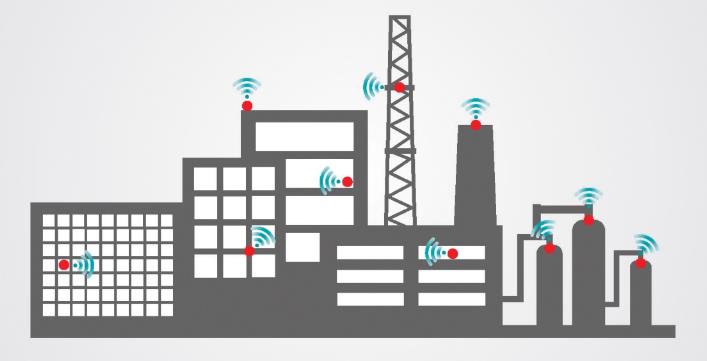Wireless Industrial Networks
18 November, 2019

As manufacturing adapts for today’s technology, principles of “Internet of Things” (IoT) are becoming more commonplace. These relatively new technologies are largely dependent on the ability to transfer data quickly and effectively across the plant. Therefore, one of the advents in industrial IoT (or IIoT) is the use of an industrial wireless network. This enables IoT solutions such as remote monitoring, and even advanced solutions such as Artificial Intelligence and Machine Learning.
Industrial Networks

An industrial wireless network is an important component to enable IoT/Industry 4.0 in manufacturing. The network should be separate from your business LAN, and typically built with different protections and redundancies in place in order to meet process needs. In general, a wireless gateway is installed and commissioned. The gateway should have a redundancy built in to its operation. The wireless signal is tested throughout the plant and boosted if needed by signal booster devices. Once the wireless network is in place, the factory can really begin to capture value.
Benefits of Wireless Connectivity

There are several reasons why you would want to utilize an industrial wireless network.
Cost Savings
There is an initial investment cost to establish the network – gateways, routers, and potentially some signal boosters. But once the network is in place, you can save thousands of dollars in wiring costs. Rather than wiring each new device to a panel, all you need to do is turn it on and connect it to the network. This becomes even bigger savings when large distances are in play, or in classified environments where specialized wiring and intrinsically safe barriers must be used.
Manageability
Reducing wiring simplifies the management of devices. Commissioning a device is typically much simpler in a wireless environment, and there is often software to assist you. It is also easier to understand the status of each device as errors can be indicated on a dashboard, rather than through troubleshooting wiring issues.
Security
With the proper redundancies in place, a separate industrial network is much safer than a business LAN. You do not want to expose your equipment to outside influence, and an industrial network will ensure your process is safe from attack. The industrial network is not connected to outside networks – there are layers of protection between. Additionally, with today’s equipment meeting modern standards, data encryption and device authentication are standard – offering a good level of security.
Possibility
Once a wireless network is in place, it starts to open possibilities that were not previously feasible. The cost barrier is lowered dramatically and is a driver in this regard. Small projects involving wireless devices become feasible for a fraction of the cost of wiring the devices. These could be error proofing projects, interlocks, additional indicators, and so on.
Redundancy
Modern wireless industrial networks have built in redundancy in their gateways, so that you don’t have to worry too much about losing functionality. Additionally, many networks and devices have built in “mesh” capability. This means that each device acts as a signal booster and path for the information to travel through. When a device is not functioning, the network adjusts and finds a new route for information to travel.
Flexibility
A huge benefit of the wireless network is the flexibility it provides. If you do not like the location of a sensor, you can simply unmount it and move it without much hassle. No rerunning conduit, wiring, or anything of that nature. No potential detailed Lock Out / Tagout procedure to follow in shutting down power, which may affect your process. Just take out the battery, remount the device in a better spot, and put the battery back in.
Considerations before going Wireless

Robustness & Maintenance
Consider the environment in which your gateways and sensors will be located. How rugged do your devices need to be in order to drive consistent value and long-lasting? Think about exposure to dust, moisture, chemicals, etc. Also, consider the long-term maintenance – will changing batteries be difficult, for example? If so, consider using energy harvesters as power sources. A longer-term rollout plan will help in this regard.
Speed
You will want to ensure your network can handle the traffic required for your processes. A slow network can be a major problem in fostering adoption at your site. Take a survey of your data needs, and design your system to exceed those needs. You likely will only be adding more data to those flows on your network.
Security
Ensure the devices you are installing meet the most up-to-date wireless standards. Take care to design your network infrastructure properly to build in levels of security. (For more information read the guide on security—LINK.)
What should you do?
Manufacturing processes are becoming more data dependent. At the same time, the expertise on the factory floor is being lost, and the “tribal knowledge” is no longer retained. Wireless industrial networks can help the business with both trends and help make device management much easier. With today’s technology, and benefits more understood and accepted, there has never been a better time to start a wireless program at your factory.










